Oregon Grape Mahonia aquifolium 'Apollo'

ABOUT
Mahonia aquifolium 'Apollo', commonly known as the Oregon grape 'Apollo', presents a visually striking appearance. It has a dense and bushy form covered in glossy, evergreen leaves that resemble those of the holly, though they are not related. Each leaflet is spiny-edged, typically displaying a deep green hue. In early spring, the Oregon grape 'Apollo' is adorned with bright yellow flowers arranged in clusters, known as racemes. These blossoms contribute a bold contrast against the dark foliage. Following the flowering period, the plant bears dark blue-purple berries. These fruits resemble small grapes, which is a contributing factor to the plant's common name. The berries are appreciated by birds and can also be used to make jellies and jams by those who value edible landscaping. Overall, the Oregon grape 'Apollo' is a hardy plant known for its attractive foliage, its vibrant yellow flowers, and its blue-purple fruit.
About this plant
 Names
NamesFamily
Berberidaceae.
Synonyms
Oregon Grape, Oregon Grape Holly, Holly-leaved Barberry.
Common names
Mahonia aquifolium 'Apollo'.
 Toxicity
ToxicityTo humans
Oregon grape (Mahonia aquifolium 'Apollo') is not generally considered highly toxic to humans, but it may contain alkaloids that could potentially cause adverse symptoms if ingested in large quantities. The berries are edible when fully ripe, though they may be quite tart. However, consuming large amounts of the berries, leaves, or other parts of the plant may lead to gastrointestinal discomfort, nausea, vomiting, and lethargy. The most concerning component is berberine, an alkaloid that can cause problem if consumed in significant amounts. Care should be taken to avoid ingesting parts of the Oregon grape that are not typically consumed, such as roots and stems, and even with the berries, moderation is key. If someone suspects poisoning from the plant, medical attention should be sought.
To pets
Oregon grape is also not highly toxic to pets, but just like in humans, the plant can cause some issues if ingested in large quantities. Pets that consume parts of Oregon grape may experience mild to moderate gastrointestinal upset, which could produce symptoms such as vomiting, diarrhea, and abdominal pain. The risk is generally greater for smaller animals, which can be affected by smaller amounts of the plant. The berries are less toxic than the roots and leaves, but still, pets should be discouraged from eating any part of the plant. If a pet is suspected of consuming a large amount of any part of Oregon grape, it is recommended to contact a veterinarian to evaluate the risk and decide if any treatment is necessary.
 Characteristics
CharacteristicsLife cycle
Perennials
Foliage type
Evergreen
Color of leaves
Green
Flower color
Yellow
Height
3-6 feet (0.9-1.8 meters)
Spread
3-5 feet (0.9-1.5 meters)
Plant type
Shrub
Hardiness zones
5-9
Native area
North America
Benefits
 General Benefits
General Benefits- Attractive Foliage - Mahonia aquifolium 'Apollo', commonly known as Oregon Grape, has evergreen leaves that provide year-round interest and color to gardens.
- Low Maintenance - Oregon Grape is known for being durable and requiring minimal care once established, making it a good choice for low-maintenance landscapes.
- Drought Tolerance - Once established, it has good resistance to drought, reducing the need for frequent watering.
- Wildlife Habitat - The plant offers shelter and food to wildlife; the berries attract birds, while the flowers can attract pollinators like bees.
- Ground Cover - Its dense growth habit makes it excellent for use as ground cover, helping to prevent weeds and soil erosion.
- Winter Interest - The plant's holly-like leaves and sometimes purple to red winter foliage color add aesthetic value to gardens during dreary winter months.
- Architectural Plant - With its bold texture and form, Oregon Grape can serve as an architectural plant, providing structure and focal points in landscape design.
- Shade Tolerance - It can thrive in partially shaded areas where other plants might struggle, making it versatile for various garden spots.
- Foundation Planting - Its moderate growth size makes it well-suited for foundation plantings without overwhelming the space.
 Medical Properties
Medical Properties- Antibacterial: Mahonia aquifolium contains compounds that have been found to have antibacterial properties, potentially useful against certain skin pathogens.
- Antifungal: The plant's extracts have demonstrated antifungal effects, possibly applicable in treating fungal infections.
- Anti-inflammatory: It has been used for its potential anti-inflammatory effects, which could help in reducing inflammation associated with particular skin conditions like psoriasis and eczema.
- Antioxidant: Mahonia aquifolium contains antioxidants that may contribute to protecting cells from oxidative damage.
- Hepatoprotective: There is some evidence to suggest that it might have liver-protective properties, though more research is needed in this area.
 Air-purifying Qualities
Air-purifying QualitiesThis plant is not specifically known for air purifying qualities.
 Other Uses
Other Uses- Dye: The berries of the Oregon Grape can be used to make a natural dye for textiles, producing shades of blue or purple depending on the mordant used.
- Photography: The berries contain a natural compound that can be used in the development of photographic images, acting as a plant-based alternative for certain chemicals.
- Ink: Juice from the berries can be boiled down to create a natural ink for writing or drawing.
- Woodworking: The wood of Oregon Grape is dense and can be used to make small carved items like handles and buttons.
- Leather Stamping: Leaves can be used to create patterns and designs on wet leather, which when dried, leaves a stamped design.
- Culinary Decoration: The bright yellow flowers can be used to decorate cakes and pastries, especially in spring-themed desserts.
- Fish Poison: Historically, some indigenous tribes used the plant as a fish poison for fishing by introducing it to streams to temporarily stun fish.
- Livestock Feed: The foliage, while not a first choice, can be a supplemental feed for livestock in times of food scarcity.
- Garden Focal Point: With its striking green foliage and bright yellow flowers, Oregon Grape can serve as an attractive focal point in a garden design.
- Water-conserving landscapes: As a drought-resistant plant, it can be used in xeriscaping, helping to reduce the need for irrigation in dry climates.
Interesting Facts
 Feng Shui
Feng ShuiThe Oregon Grape is not used in Feng Shui practice.
 Zodiac Sign Compitability
Zodiac Sign CompitabilityThe Oregon Grape is not used in astrology practice.
 Plant Symbolism
Plant Symbolism- Protection: Mahonia aquifolium, commonly known as Oregon Grape, has spiny leaves reminiscent of holly. This physical characteristic has led to its association with protection and defense.
- Healing: Oregon Grape has medicinal properties and is often used in herbal remedies for its anti-inflammatory and antibacterial benefits, symbolizing healing and recovery.
- Resilience: Oregon Grape is a tough, hardy plant capable of thriving in various challenging conditions, thus symbolizing resilience and adaptability.
- Nature's Balance: As an evergreen plant, the Oregon Grape maintains its foliage throughout the year, representing the balance and consistency of nature.
- Prosperity: The yellow flowers and subsequent purple berries can be seen as symbols of abundance and prosperity.
 Water
WaterThe Oregon Grape 'Apollo' should be watered thoroughly, allowing the soil to become moderately dry between waterings. During the growing season, typically in spring and summer, it may need watering approximately once a week, with about 1 to 2 gallons of water each time, depending on climate and soil drainage. In the fall and winter, reduce watering frequency to every other week or less, as the plant requires less moisture when dormant. Ensure the plant is never left in standing water to prevent root rot.
 Light
LightOregon Grape 'Apollo' thrives best in partial shade to full sun. An ideal spot for planting is one where it can receive bright, indirect light in the morning with some afternoon shade, or dappled sunlight throughout the day. Too much direct, intense sun can cause leaf scorch, while deep shade can reduce flowering and fruiting, so aim for a balance in its lighting conditions.
 Temperature
TemperatureOregon Grape 'Apollo' is hardy and can tolerate a range of temperatures. It can survive minimum temperatures down to around 0°F and is comfortable in maximum temperatures up to around 95°F. However, the ideal temperature range for this plant is between 60°F and 75°F. Ensure proper mulching to protect the roots in colder zones.
 Pruning
PruningPrune Oregon Grape 'Apollo' to maintain its shape and to remove any dead or diseased wood. This should be done after flowering, typically in late spring or early summer. Pruning can be performed annually or as needed to control the size of the plant and encourage the growth of new, healthy shoots.
 Cleaning
CleaningAs needed
 Soil
SoilOregon Grape 'Apollo' thrives in well-draining soil, rich in organic matter, with a pH range of 5.5 to 7.0. A mix of 60% garden soil, 30% compost, and 10% perlite or sand can be ideal, ensuring moisture retention yet avoiding waterlogging.
 Repotting
RepottingOregon Grape 'Apollo' generally needs repotting every two to three years to refresh the soil and allow for root growth. The best time to repot is in the spring or early fall.
 Humidity & Misting
Humidity & MistingOregon Grape 'Apollo' prefers moderate humidity levels and can tolerate some dry air but thrives best when the humidity is around 40-60%.
 Suitable locations
Suitable locationsIndoor
Place in bright indirect light, maintain cool temps.
Outdoor
Use well-draining soil, part-shade to full sun.
Hardiness zone
5-9 USDA
 Life cycle
Life cycleOregon grape 'Apollo' begins as a seed, which, once germinated in appropriate soil and environmental conditions, develops into a seedling. The seedling matures into a shrub, developing compound, holly-like evergreen leaves. As the plant matures, it produces clusters of yellow flowers in early spring, which are pollinated by insects. Following pollination, the flowers develop into small purple-blue, grape-like fruits by late summer. These fruits contain seeds that can disperse to begin new plants, thus continuing the life cycle. As a perennial, Oregon grape 'Apollo' will continue to grow and can spread vegetatively by underground stems, contributing to the development of dense patches or colonies.
 Propogation
PropogationPropogation time
Spring-Early Summer
The Oregon grape 'Apollo' can be propagated most effectively by semi-hardwood cuttings taken in late summer. To accomplish this, cut a 4 to 6 inch (10 to 15 cm) length of stem that has matured slightly but is not fully hardened. Remove the lower leaves and dip the cut end into a rooting hormone to enhance rooting success. Plant the cutting in a mixture of perlite and peat moss, ensuring the cutting is firmly in place but not too deep to avoid rot. Place the pot in a warm, well-lit area but out of direct sunlight to avoid scorching the cutting, and maintain consistent moisture without letting it become waterlogged. With proper care, roots will develop in a few weeks, after which it can be transplanted into a more permanent location.
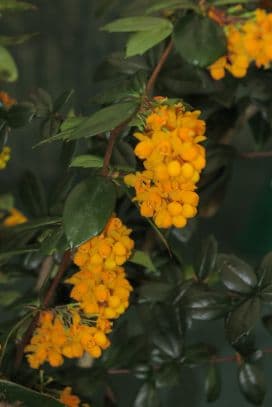
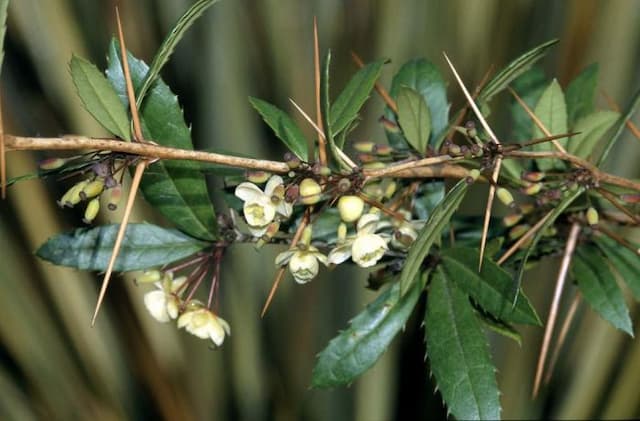
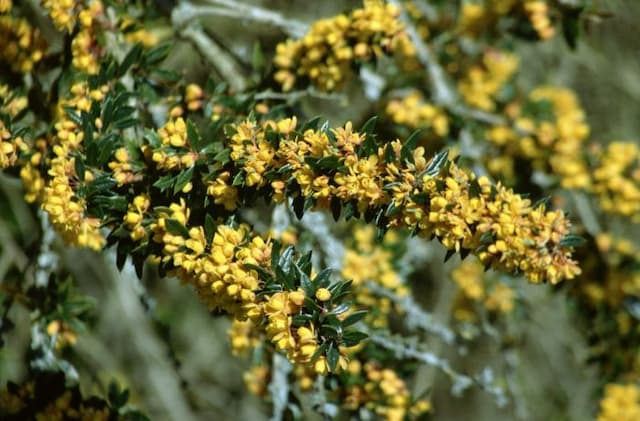
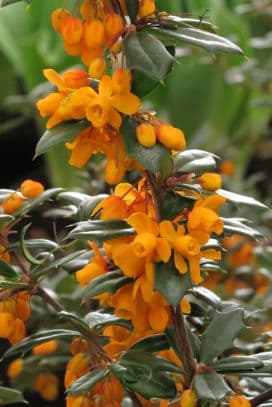
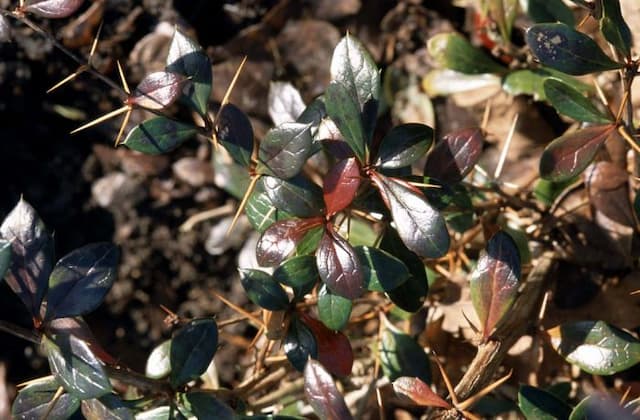


![Japanese barberry [Bonanza Gold]](/_next/image?url=https%3A%2F%2Fplants-admin.emdemapps.com%2Fimages%2Fplants%2F%2Fimages%2F604b5385e413f.png&w=640&q=75)

